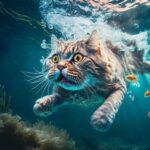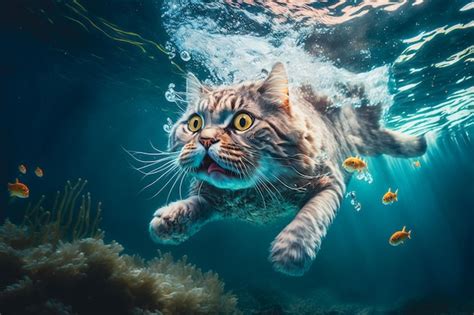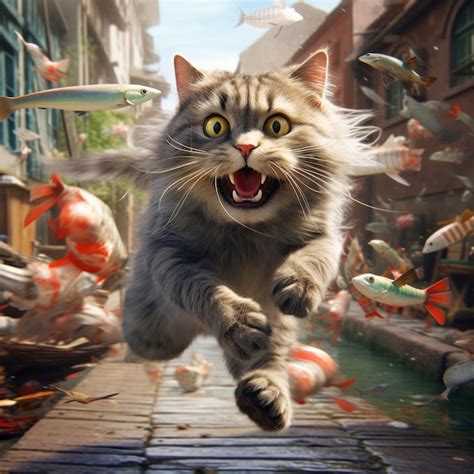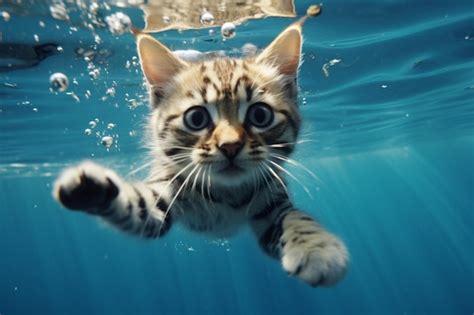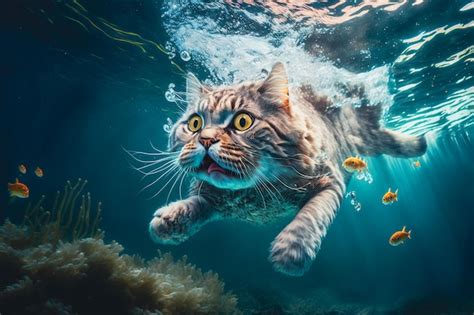
AI-generated images of cats performing elaborate dives have taken the internet by storm, sparking humorous speculation about a future Olympic sport and highlighting the increasing sophistication and sometimes bizarre outputs of artificial intelligence.
The viral trend, fueled by AI image generators, showcases felines executing perfect flips, twists, and dives with impeccable form, all within the context of a competitive swimming pool environment. While these images are entirely fictional, they underscore the rapid advancements in AI’s ability to create realistic and often surreal content, leading to both amusement and discussions about the technology’s potential and limitations.
The AI-generated “cat diving” phenomenon began gaining traction across social media platforms, with users sharing images and videos of these athletic felines. The images depict cats in various diving poses, complete with water splashes, judges’ scorecards, and Olympic signage, creating a convincing, albeit clearly fabricated, sporting event. As the images circulated, many users jokingly suggested that “cat diving” should be considered as a new Olympic sport, further amplifying the trend’s popularity.
“Didn’t realize cats doing the most amazing dives was something I needed to see,” wrote one user on X (formerly Twitter), encapsulating the widespread reaction to the AI-generated spectacle. The sentiment reflects a broader fascination with AI’s capacity to generate unexpected and entertaining content.
The creation of these images relies on sophisticated AI models trained on vast datasets of images and text. These models, often referred to as generative AI, can interpret textual prompts and translate them into visual representations. In the case of “cat diving,” users likely provided prompts describing cats performing diving maneuvers, and the AI then generated images based on its understanding of those prompts.
The realism of the AI-generated images is a testament to the progress made in the field of artificial intelligence. Just a few years ago, AI-generated images were often blurry, distorted, or obviously artificial. However, advancements in algorithms and training data have enabled AI models to produce images that are increasingly difficult to distinguish from real photographs. This capability has numerous potential applications, ranging from art and design to education and entertainment.
However, the “cat diving” trend also highlights the potential pitfalls of AI-generated content. While the images are clearly intended as humor, the increasing realism of AI-generated images raises concerns about the potential for misuse. AI could be used to create fake news, propaganda, or other forms of disinformation, making it more difficult for people to distinguish between fact and fiction.
The spread of AI-generated content also raises ethical questions about copyright and intellectual property. If an AI model is trained on copyrighted images, does the AI-generated content infringe on those copyrights? This is a complex legal issue that is still being debated by experts. Furthermore, the ease with which AI can generate content raises questions about the value of human creativity. If AI can create art, music, and literature, what role will humans play in these fields in the future?
Despite these concerns, the “cat diving” trend serves as a reminder of the creative potential of AI. By combining human imagination with AI technology, it is possible to create new and unexpected forms of art and entertainment. As AI continues to evolve, it is likely that we will see even more innovative and imaginative applications of this technology.
The popularity of the “cat diving” images can also be attributed to the internet’s enduring fascination with cats. Cats have long been a staple of online culture, appearing in countless memes, videos, and social media posts. Their quirky personalities, playful antics, and undeniable cuteness make them ideal subjects for online content. The combination of cats and AI technology has proven to be a winning formula, capturing the attention of millions of people around the world.
Beyond the humor and entertainment value, the “cat diving” trend offers a glimpse into the future of AI-generated content. As AI models become more sophisticated, they will be able to generate even more realistic and believable images, videos, and audio. This will have profound implications for a wide range of industries, from media and marketing to education and healthcare.
In the media industry, AI could be used to create personalized news content, generate realistic special effects for movies and television shows, and even write articles and scripts. In the marketing industry, AI could be used to create targeted advertising campaigns, generate product descriptions, and even design logos and websites. In the education industry, AI could be used to create personalized learning experiences, generate educational videos, and even provide students with individualized feedback. In the healthcare industry, AI could be used to diagnose diseases, develop new treatments, and even provide patients with virtual care.
However, the widespread adoption of AI-generated content will also require careful consideration of ethical and societal implications. It is important to develop guidelines and regulations to ensure that AI is used responsibly and ethically. This includes addressing issues such as bias, transparency, and accountability. It is also important to educate the public about the capabilities and limitations of AI so that they can make informed decisions about how to use this technology.
The “cat diving” phenomenon, while lighthearted, serves as a microcosm of the broader AI revolution. It demonstrates the power of AI to generate creative and engaging content, while also raising important questions about the ethical and societal implications of this technology. As AI continues to evolve, it is crucial to engage in open and honest discussions about its potential and its challenges.
The trend also highlights the human element in the creation of AI art. While the AI generates the image, it is the human who provides the prompt, curates the results, and shares them with the world. This collaborative process underscores the importance of human creativity and imagination in the age of AI.
The virality of the “cat diving” images is a testament to the power of social media. Platforms like X, Instagram, and TikTok have made it easier than ever for people to share and discover content from around the world. This has created a global community of users who are constantly sharing and remixing content, leading to the rapid spread of viral trends like “cat diving.”
The phenomenon also speaks to the human desire for novelty and amusement. In a world that is often filled with stress and uncertainty, people are drawn to content that is lighthearted and entertaining. The “cat diving” images offer a brief escape from reality, allowing people to laugh and share in a moment of collective amusement.
In conclusion, the AI-generated “cat diving” trend is more than just a collection of funny images. It is a reflection of the rapidly evolving landscape of artificial intelligence, the enduring appeal of cats, and the power of social media to spread ideas and trends around the world. As AI continues to develop, it is likely that we will see even more unexpected and imaginative applications of this technology, raising new questions and challenges for society to address. The future of AI is uncertain, but one thing is clear: it will continue to shape our world in profound ways. The rise of AI-generated content necessitates ongoing discussions about its ethical implications, creative possibilities, and its role in shaping human perception and reality. The seemingly simple amusement of AI-generated cats diving opens up a much broader conversation about the future of creativity, technology, and society.
The “cat diving” trend is a perfect example of how AI can be used to generate creative and engaging content. It is also a reminder that AI is still a tool that is controlled by humans. It is up to us to use AI responsibly and ethically, and to ensure that it benefits all of humanity. The playful nature of this trend should not overshadow the important discussions it sparks about the future of AI and its role in our lives. As AI technology continues to advance, it is crucial that we engage in thoughtful and informed discussions about its potential impact on society, ensuring that we harness its power for good while mitigating potential risks.
Frequently Asked Questions (FAQs):
1. What exactly is “AI-generated cat diving”?
“AI-generated cat diving” refers to images and videos created by artificial intelligence algorithms depicting cats performing various diving maneuvers, often in a competitive swimming pool setting. These images are entirely fictional and are generated based on textual prompts given to AI image generators. The trend gained popularity on social media due to its humorous and surreal nature.
2. How are these AI-generated cat diving images created?
These images are created using generative AI models. Users input textual prompts, such as “a cat doing a backflip dive” or “a cat receiving a perfect 10 score in diving,” into an AI image generator. The AI model then uses its training data (vast datasets of images and text) to interpret the prompt and generate a visual representation of the scene described. The quality and realism of the image depend on the sophistication of the AI model and the clarity of the prompt.
3. What are the potential concerns surrounding AI-generated images like these?
While the “cat diving” images are harmless, the increasing realism of AI-generated content raises several concerns. These include:
- Misinformation: AI can be used to create fake news and propaganda that is difficult to distinguish from reality.
- Copyright Infringement: AI models trained on copyrighted images may generate content that infringes on those copyrights.
- Ethical Concerns: The ease with which AI can generate content raises questions about the value of human creativity and the potential for AI to displace human workers.
- Deepfakes: AI can create realistic fake videos of people saying or doing things they never actually did, which can have serious consequences for their reputation and safety.
4. Why did this “cat diving” trend become so popular?
The popularity of the “cat diving” trend can be attributed to several factors:
- Humor and Surrealism: The images are inherently funny and unexpected, offering a lighthearted escape from reality.
- Internet’s Love for Cats: Cats are a popular subject on the internet, and combining them with AI technology has proven to be a winning formula.
- Social Media Sharing: Platforms like X, Instagram, and TikTok make it easy to share and discover viral content.
- Novelty: The novelty of seeing cats performing athletic feats that are impossible in reality captured the attention of a wide audience.
5. What does this trend tell us about the future of AI and creativity?
The “cat diving” trend provides insights into the future of AI and creativity:
- AI as a Creative Tool: AI can be used as a powerful tool for creative expression, allowing users to generate new and unexpected forms of art and entertainment.
- Human-AI Collaboration: The creation of AI art often involves a collaboration between humans and AI, with humans providing the prompts and curating the results.
- Ethical Considerations: The widespread adoption of AI-generated content requires careful consideration of ethical issues such as copyright, bias, and accountability.
- Shifting Definitions of Creativity: As AI becomes more capable of generating creative content, it may challenge our traditional notions of creativity and authorship.
Expanding the Article with Additional Details and Context:
The Technical Underpinnings of AI Image Generation
Understanding how these AI-generated images are created requires a look at the technology powering them. Generative Adversarial Networks (GANs) and diffusion models are two prominent types of AI architectures used for image creation.
-
GANs: GANs consist of two neural networks: a generator and a discriminator. The generator creates images, while the discriminator tries to distinguish between real images and those generated by the generator. Through a process of continuous feedback and improvement, the generator becomes increasingly adept at producing realistic images that can fool the discriminator.
-
Diffusion Models: Diffusion models work by gradually adding noise to an image until it becomes pure noise. The model then learns to reverse this process, gradually removing noise to reconstruct the original image. By manipulating the denoising process, the model can generate new images that resemble the training data but are not identical to any specific image.
These models are trained on massive datasets of images and text, allowing them to learn the relationships between words and visual representations. When a user provides a text prompt, the AI model uses its knowledge to generate an image that matches the description.
Ethical and Societal Implications: A Deeper Dive
While the “cat diving” trend is lighthearted, it highlights broader ethical and societal implications of AI-generated content that warrant serious consideration.
-
Bias Amplification: AI models are trained on data that may contain biases, which can then be amplified in the AI-generated content. For example, if the training data contains mostly images of white people, the AI model may generate images that perpetuate racial stereotypes.
-
Job Displacement: As AI becomes more capable of generating content, there is a risk that it will displace human workers in creative industries such as graphic design, writing, and music.
-
Erosion of Trust: The proliferation of AI-generated content can erode trust in media and information. If people can no longer be sure that what they see or hear is real, it can lead to increased skepticism and distrust.
-
The Nature of Authenticity and Originality: The rise of AI generated art challenges the very notion of what it means to be authentic and original. If an AI can generate works in the style of famous artists, does it diminish the value of their original creations? This has opened up debates in art circles about the nature of ownership, inspiration, and the definition of art itself.
The Role of Human Creativity in the Age of AI
Despite the increasing capabilities of AI, human creativity remains essential. AI is a tool that can augment human creativity, but it cannot replace it entirely. Humans are needed to provide the prompts, curate the results, and add their own unique perspectives and interpretations.
-
Prompt Engineering: Crafting effective prompts is a crucial skill in AI art generation. The more specific and detailed the prompt, the better the AI model will be able to generate an image that matches the user’s vision.
-
Post-Processing: AI-generated images often require post-processing to refine the details, correct imperfections, and add personal touches.
-
Conceptualization and Storytelling: AI can generate images, but it cannot create the underlying concepts and stories that give those images meaning. Humans are still needed to come up with original ideas and narratives.
The Legal Landscape of AI-Generated Content
The legal landscape surrounding AI-generated content is still evolving. There are many unanswered questions about copyright, ownership, and liability.
-
Copyright: It is unclear who owns the copyright to AI-generated content. Is it the user who provided the prompt, the developer of the AI model, or someone else entirely? This is a complex legal issue that is still being debated by experts.
-
Ownership: Similarly, it is unclear who owns the AI model itself. Is it the company that developed the model, the users who contributed to its training data, or the individuals who use it to generate content?
-
Liability: If an AI-generated image causes harm, who is liable? Is it the user who provided the prompt, the developer of the AI model, or the company that distributed the image?
These legal questions need to be addressed in order to ensure that AI-generated content is used responsibly and ethically.
The Future of AI-Generated Content: Trends and Predictions
The field of AI-generated content is rapidly evolving, and there are several trends and predictions that are worth noting.
-
Increased Realism: AI models are becoming increasingly sophisticated, and they are able to generate images, videos, and audio that are virtually indistinguishable from reality.
-
Personalization: AI will be used to create personalized content that is tailored to individual users’ interests and preferences.
-
Automation: AI will automate many of the tasks that are currently performed by human content creators.
-
Integration: AI will be integrated into a wide range of applications and services, from social media to e-commerce to education.
As AI continues to evolve, it is likely that we will see even more unexpected and imaginative applications of this technology. It is important to stay informed about these developments and to engage in thoughtful and informed discussions about their potential impact on society.
Examples of AI-Generated Art and Content Beyond “Cat Diving”
The “cat diving” trend is just one example of the many creative applications of AI. Here are a few other notable examples:
-
AI-Generated Music: AI models can compose original music in a variety of styles, from classical to electronic. Companies like Amper Music and Jukebox are using AI to create music for advertising, film, and other applications.
-
AI-Generated Writing: AI models can write articles, blog posts, and even novels. Tools like GPT-3 are being used to automate content creation and to assist writers with their work.
-
AI-Generated Art: AI models can create paintings, sculptures, and other forms of art. Artists like Refik Anadol are using AI to create stunning and immersive installations.
-
AI-Generated Video: AI models can create realistic fake videos of people saying or doing things they never actually did. This technology, known as deepfakes, has raised concerns about misinformation and manipulation.
These examples demonstrate the wide range of creative possibilities that AI offers. As AI continues to evolve, it is likely that we will see even more innovative and imaginative applications of this technology.
Addressing Concerns and Misconceptions about AI
It’s important to address some common concerns and misconceptions about AI, particularly in the context of creative content generation.
-
AI is not sentient: AI models are not conscious or sentient. They are simply complex algorithms that are trained to perform specific tasks. They do not have feelings, intentions, or the ability to think for themselves.
-
AI is not a replacement for human creativity: AI is a tool that can augment human creativity, but it cannot replace it entirely. Humans are still needed to provide the ideas, concepts, and emotions that give art its meaning and value.
-
AI is not perfect: AI models are not perfect, and they can make mistakes. They can also be biased or unfair. It is important to be aware of these limitations and to use AI responsibly.
-
AI is not a threat to humanity: AI is a powerful technology, but it is not inherently dangerous. It is up to us to use AI wisely and ethically, and to ensure that it benefits all of humanity.
The Importance of Education and Awareness
In order to navigate the rapidly evolving landscape of AI, it is essential to promote education and awareness.
-
Educate the public about AI: It is important to educate the public about the capabilities and limitations of AI, as well as the ethical and societal implications of this technology.
-
Promote critical thinking skills: People need to be able to critically evaluate AI-generated content and to distinguish between fact and fiction.
-
Encourage responsible AI development: AI developers need to prioritize ethical considerations and to ensure that their models are fair, transparent, and accountable.
-
Foster collaboration: It is important to foster collaboration between researchers, policymakers, and the public to address the challenges and opportunities presented by AI.
Conclusion: Embracing the Future of AI with Caution and Optimism
The AI-generated “cat diving” trend is a playful reminder of the transformative potential of artificial intelligence. While it’s easy to be captivated by the novelty and humor of such creations, it’s crucial to engage in deeper discussions about the implications of AI on creativity, ethics, and society. The key is to approach the future of AI with a balanced perspective – embracing its potential while remaining mindful of its challenges. We must foster responsible development, promote education and awareness, and ensure that AI serves humanity’s best interests. By doing so, we can harness the power of AI to create a more innovative, equitable, and fulfilling future for all.




